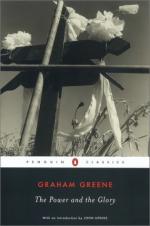|
This section contains 220 words (approx. 1 page at 400 words per page) |

|
Even though Greene parodies conventional, sentimental stories of saints' lives, the novel does stand in that tradition, and, even though it is not as sentimental as much popular religious literature, it has much in common with the Quo Vadis? legend, in which Saint Peter, escaping his imprisonment in Rome, is confronted by the risen Christ. When Peter asks Christ, quo vadis? (where are you going?), Christ replies "to Rome, to be crucified," and Saint Peter follows him back to Rome and his own martyrdom, just as the priest follows his calling back to his imprisonment and martyrdom.
Yet Greene's departure from conventional piety, in making his priest a "sinful" man, has helped lead modern Catholic literature in a new, less sentimental direction. Evelyn Waugh, another English Catholic, published Brideshead Revisited, certainly an unsentimental view of Catholicism in 1945, slightly after The Power and the Glory, and orthodox...
|
This section contains 220 words (approx. 1 page at 400 words per page) |

|




